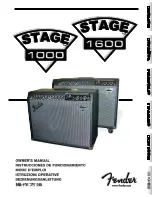
used. If you have a stereo (3-conductor) plug only, tie the ring and the sleeve (ground) together.
If you are not getting any “effect” through the speakers, check the position of the Effects Blend control.
EXTENSION SPEAKER JACK
Use an unshielded 2-conductor cable (NOT A GUITAR CORD!) to connect an additional speaker cabinet.
Use a high quality, heavy gauge cable of at least 18 gauge (the lower the gauge, the heavier the cable).
The impedance of the speaker should be 8 ohms or greater. If you wish to connect two additional cabi-
nets be sure their combined impedance is not less than 8 ohms (equivalent to two 16 ohm speaker
cabinets in parallel).
Recommended speaker cabs from SWR are:
Workingman’s 1X10T, Workingman’s 1X15T,
Workingman’s 2X10T, Workingman’s 4X10T.
STEREO HEADPHONES JACK
By inserting a set of stereo headphones into this jack you will be able to monitor your sound or practice
without disturbing your neighbors. The headphone volume level is adjusted by the Volume control. We
suggest you begin with the Volume off (fully counterclockwise), then slowly bring the volume up to your
desired level. If you hear some distortion in your headphones that is not present with the speakers on,
turn down the volume—you are overdriving your headphones and could ruin them.
Any impedance stereo headphones will work. However, optimum impedance is 75 ohms.
THREE WAY SELECTOR SWITCH
The top position, labeled
Full Range
, activates both the tweeter and the 10" woofer in the
WorkingMan’s 10, as well as the extension speaker jack. This position is the most typical setting.
The middle position, labeled
Headphones Only
, disconnects the signal going to the internal speakers and
extension speaker jack. Use this position when listening with heaphones only or for silent tuning (refer to To
Tuner section). The Headphones jack is always active regardless of the switch’s position.
The bottom position, labeled
Horn Off
, disconnects the tweeter located in the upper right hand corner of
the speaker cabinet. It will not affect the 10" woofer, headphones or any extension cabinet. If you prefer
a “darker” sound or are getting a lot of fret buzz, clicks, or pick or finger noise, you may want to use this
position.
BALANCED DIRECT RECORD OUT
The Balanced XLR output is a true balanced output. No front panel controls affect its signal. The tone and
output level are controlled only by the instrument plugged into one of the input jacks. To use this feature,
run an XLR (Cannon) cable from the Balanced D.I. to the input of a tape machine, mixing console, etc.
This output is also suitable for sending a signal to a house mixer in live situations.
Wiring for the XLR connector is as follows: Pin 1 = ground, Pin 2 = +, Pin 3 = –. (American standard)
NOTE:
Do not apply phantom power (48V supply) to this output. Doing so may damage the inter-
nal circuitry.
A/C LINE FUSE
The line fuse can open (blow) due to power surges or high powerline transients. This fuse will also open
in the event of an electronics failure inside your amplifier. Correct size and rating of the Line (Mains)
fuse: 3AG, 2 amp slo-blow for 120V operation (North America), and 1 amp slo-blo for 240V operation.
A/C LINE CORD RECEPTACLE
Accepts a standard A/C power cable (supplied with the Workingman’s 10 in the United States), used with
almost all current musical, professional and household electronic devices. If it becomes misplaced,
WORKINGMAN’S COMBOS OWNER’S MANUAL •
55
Summary of Contents for WORKINGMAN'S 10
Page 8: ...6 6 WORKINGMAN S COMBOS OWNER S MANUAL WORKINGMAN S WORKINGMAN S 10 10 Suggested Settings...
Page 15: ...WORKINGMAN S WORKINGMAN S 12 12 Suggested Settings WORKINGMAN S COMBOS OWNER S MANUAL 13 13...
Page 22: ...20 20 WORKINGMAN S COMBOS OWNER S MANUAL WORKINGMAN S WORKINGMAN S 15 15 Suggested Settings...







































